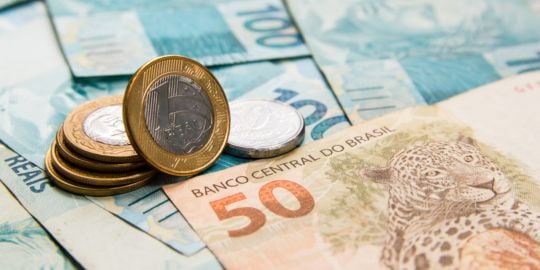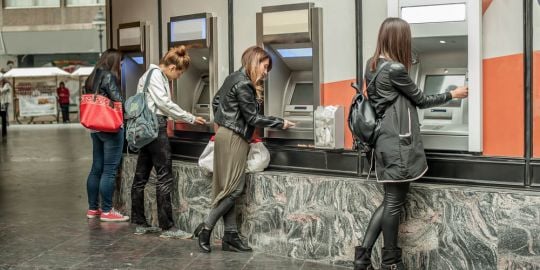Since most expats play the currency trading game. How close are the future predictions of the value of the Real. I like this site it goes out for 3 years. It may help you to know or when to see the future. I like to review this each month to see how closely there predictions. Hope this helps
Where is the Brazilian Real going vs US dollar
Most countries seem to be seeing a drop compared to the USD.
I suspect a little manipulation is going off.
@NewBrazil
Yes, I have been watching that site for a few years. However their predictions are solely based on the rate today, and cannot foresee how future events will impact exchange rates. When the dollar was at 3.5 or 4.5, they predicted years of around that level, but when it suddenly jumped up their forecasts did likewise, but only after the jump.
For example they could not have known about Russia invading Ukraine or the terrorist actions of Hamas. Neither can they predict the result of the US Presidential elections in November, nor the Brazilian one in 2.5 years; the rise of right wing parties in southern EU may damage the EU itself, and Brazil could suddenly discover new oil deposits. All these did or could significantly affect the exchange rates, but are impossible to know about for certain this far away.
I suspect that their algorithms are not based on geopolitical predictions and more on historical annual movements - but then again, I know nothing of these things!
Right now, the domestic agenda is controlled by commodity producers ( beef, poultry, soy beans, fruits, processed pulp paper, airplanes not assembled in premises ).
So stands to reason, the R$ 5 per dollar will continue, for as long as it favors exporters. who are the very same commodity producers.
In the 80's and 90's we had the same predicament, only it was compounded by high inflation rates. Back then were exports of Auto Parts, Poultry, Assembled Vehicles, Soybean, footwear.
The Central Bank makes sure rates stay favorable to exporters and importers, tilting favorably towards the former.
If you want to hedge your currency, keep an eye on "Politica Monetaria e Fiscal , and Balanca Comercial.
And then there is the secondary market, outside the purview of the Central Bank, much to their chagrin. We used to have different dollar exchange ratios. The Official, the Tourism, and the Black Market. The later was controled by :"Doleiros", whom everyone went to buy dollars for safekeeping or travel abroad.
Learn Portuguese, subscribe for a Financial New Daily ( Valor Economico being the most recommended read ), keep an eye on the indicators,, befriend a Doleiro, and you will get a handle on how the rates are heading to, if you want to play arbritrage games.
Remember as well that BRL exchange rates can be affected just as much by factors outside Brazil as inside. For example, if these right wing groups in S Europe start threatening the very existence of the EU as it is now, watch the euro drop...
I was hopping they were right but on Tuesday. The rate was over 5.20 then in 4 days. Now it 5.07 I have seen the central bank in Brazil. They will interject dollas that move the rate down. So do you think it will go backup since Brazil just was talking about food prices going up again. Since there is a drought and effected the crops. Thank for all your responses.
@NewBrazil You're trying to somehow use logic regarding the value of currencies. More often than not, the price is driven by pure speculation based upon nothing other than the brute force of banks and large investors buying and selling. The only thing worse is digital currencies such as Bitcoin, which are truly based on nothing.
Speaking specifically about Bitcoin, in my opinion, its value is grounded in tangible factors today. Apart from being the first decentralized system, its value is supported by the costs of mining and its properties, such as limited supply. Bitcoin has real-world use cases and has developed a complete ecosystem. It serves as an alternative in many countries where the financial system is not trusted and is failing its own people.
Brazilian economy is showing a steady recovery and robust gdp growth. Inflation is controlled. If Fernando Haddad puts public spending in check in the years to come and once interest rate starts to fall in the US, brazilian real could surprise and go all the way to 4,50 range. If Brazil manages to recover the Moody's investment grade, that could give the real additional push. However until the US interest rates do not start to fall, i expect the real to stay in the 5 range (+- 3 percent).
@EdyNoBrasil Your prognostication is that the dollar will be 2-8 real in coming years?
@alan279 by -+ 3% i meant: 4.85 - 5.15. As it looks like the Fed won't start to reduce the interest rates until September, so i believe usd/brl will stay in the range of 4.85 - 5.15 until then. If public spending will be controlled in years to come and foreign investment will increase + falling us interest rates i expect stronger real, usd/brl around 4.5
I have been in Brazil long enough to remember when US investors were getting a rate of 1.6...! I do not think it will go that low any time soon, but at least one American analyst is predicting the US stock market will collapse at some point in the near future, and that will severely weaken the dollar.
If that were to happen I think the dollar will go well below 4.85...
I remember 1.6 too.
I was hopping they were right but on Tuesday. The rate was over 5.20 then in 4 days. Now it 5.07 I have seen the central bank in Brazil. They will interject dollas that move the rate down. So do you think it will go backup since Brazil just was talking about food prices going up again. Since there is a drought and effected the crops. Thank for all your responses.
-@NewBrazil
If food stuffs surge, then the real should go lower, not higher.
There are staple items that are imported. From Argentina, Chile.
Yet, Real pegged to Food Prices is more likely then as Food Prices x Reals.
And food prices have not much to do with currency floating rates. It's Agrcultural output, or shortages that determine food prices at the retail.
Go visit your City's Wholesale market, interact with vendors, and you will get a better grasp of what I just stated.
The real exchange ratio has a lot more to do with the "Balanca Comercial" or the volume of trade between imports and exports. You hear that term often, because it bears reality to currency exchange rates.
I was hopping they were right but on Tuesday. The rate was over 5.20 then in 4 days. Now it 5.07 I have seen the central bank in Brazil. They will interject dollas that move the rate down. So do you think it will go backup since Brazil just was talking about food prices going up again. Since there is a drought and effected the crops. Thank for all your responses.
-@NewBrazil
" effected " you meant affected. Your keystrokes are firing up to fast. Same with "dollas". Slow down.
The only time food prices are affected by exchange rates is when your staple item is imported. And with pricing other factors weigh in on pricing.
About five years ago you could've gotten a half litre of Extra Virgin Olive Oil for R$ 22,00 apiece. Now, it hovers at R$ 42,00 at the shelves of your discount chain grocer..
In the same time frame, your Bananas have pretty much stayed at the same rates, given or taken inflation adjustments.
The Bottle of Olive Oil has surged beyond your inflationary adjustment rate. In a period where the dollar has hovered around R$ 5 to 1 USD , no less.
Here are some plausible reasons...
1.There's been a surge in the consumption of Extra Virgin Olive Oil, on the account of consumer's health awareness and the heralded benefits of extra virgin olive oil. People are no longer taking the dilluted variety ( with Soy Oil mostly ).
In fact there are local TV shots of educating consumers about avoiding faked Extra Virgin Olive Oil. Brazilian Consumers are getting their religion on Olive Oil.
2.Europe, and to some extent North Africa ( your Italian Extra Virgin is grown and pressed in Tunisia ), is undergoing severe regional droughts. That affects supply.
3.Chilean, Brazilian grown and pressed Extra Virgin are barely on the radar of Brazilian Consumers, and have little shelf presence. Portuguese Olive Oil ranks atop. The superb Greek Olive Oil is a luxury for Brazilian consumers as w whole. It's Portuguese First, Spanish Second, and italian Third.
So fixed and diminishing supply, and surging demand. Take a wild guess what it will do to prices....
You can't predict what the currency will do, until you get out in front of your computer!! You need to get your bearings.
Now that Brazil is tell the population that food prices are going up. It because of the drought and basic food that effected like rice. Now we will see how it affect the Real.
@alan279 by -+ 3% i meant: 4.85 - 5.15. As it looks like the Fed won't start to reduce the interest rates until September, so i believe usd/brl will stay in the range of 4.85 - 5.15 until then. If public spending will be controlled in years to come and foreign investment will increase + falling us interest rates i expect stronger real, usd/brl around 4.5
-@EdyNoBrasil
The FED won't be able to cut rates in a looong while. Count on that.
They have to issue debt that is attractive to bond investors. The interest in the bond market is lukewarm, as of now.
Sovereign Debt, well , outside Japan, no takers. And the FED has been repurchasing bonds for quite a while.
Why do you think they sent Janet Yellen to China? Certainly not to negotiate fair trade. That was a hat in hand mission.
They have to give better teasing rates, and in doing so, increasde indebtdeness and risk.
Now that Brazil is tell the population that food prices are going up. It because of the drought and basic food that effected like rice. Now we will see how it affect the Real.
-@NewBrazil
Two separate entities....
Food supply and currency exchange rates.
If consumer prices go up, so do wholesale prices. Which means less tendency to export surpluses, and more towards importing for the gaps. Which translates into a stronger Real.
Since most expats play the currency trading game. How close are the future predictions of the value of the Real. I like this site it goes out for 3 years. It may help you to know or when to see the future. I like to review this each month to see how closely there predictions. Hope this helps
https://longforecast.com/brazilian-real … 21-usd-brl-@NewBrazil
Just a word of caution regarding the information on this site. I cannot see the confidence level of the predictions.
Nowadays, it is easy to create a trained model based on past data with just 30 mins on any cloud service platform. What is harder is to know how accurate the model is and how sensitive the model will be to perturbations.
Since it appears that the predictions appear to based on data from 2017 onwards, I suspect that this model is trained on data with the exchange rate going up rather than going down. The exchange rate in 2017 was in the neighborhood of R$ 3.
Not sure whether the model will be able to predict issues such as effects of climate change or the impact of breakthrough technologies and / or wars.
At the very minimum, I would like to understand whether the predictions are converging or diverging.
I would not put a lot of trust on the data on this site. I have not seen an abililty to predict large currency swings - which is obviously the largest risk for someone doing a currency hedge here.
@Pablo888 Sorry, my crystal ball has been broken for years now, and I can't predict the future. 🙁
Some food for thought....
Just see how much in bonds notes and bills are coming due against of the amount tendered in the market.
Then see all of foreign trade transactions that are not being booked with dollar exchanges. That number is hard to fathom. But is is growing. Regardless of whether BRICs become viable or not.
Then dig deeper and find out how much debt percentage is being rolled over as the existing debt matures.
The years of low interest under Alan Greenpan, they are gone for good. Cheap money is already earmarked to bankroll sure thing projects that involves reshoring manufacturing.
Available cheap money is not going to make consumer credit affordable for a long time out. There's a finite amount of how much cheap money is earmarked to be dolled out, whether it is to grow crops, finance consumer purchases, take risks with start ups.
Long before Obama took office I had analysts telling me the US rate of savings, that is household rate of savings, were historically at the lowest point ever.
Now all of that cheap money meant the US Economy was flush with cash. That's when you had money chasing poor valuations, bad IPOs, unicorn IPOs, cheap consumer credit, funding overseas risk projects.
That cash surplus had a couple sources....
Baby Boomer's savings
Pension Funds.
The former is being pulled out of the markets as Baby Boomers cash out towards retirement. Part of that money is going into stable securities, such as bonds, bills, and notes. This is a massive contingent of people cashing out. Largest ever.
Pension Funds , well they've been raided consistently since the 80's by Private Equity, Speculators. Some have gone belly up. Some are over funded, some are underfunded.
If you though you could bet on the dollar towards gains against the Real, then think again.
@Pablo888 Sorry, my crystal ball has been broken for years now, and I can't predict the future. 🙁
-@alan279
Yes. It's not easy to predict the future. However, it is possible to do a better educated guess based on data aggregation and AI. This has been and is currently being done in various industries in first world countries. However, I am not sure whether Brazil has started on this path yet.









